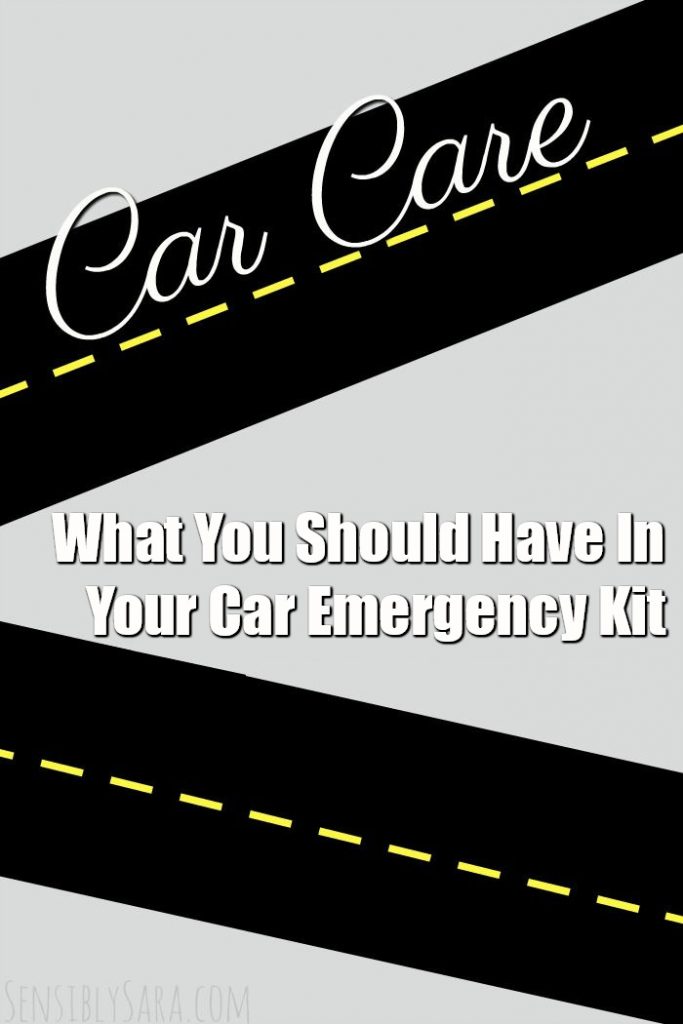According to MFASCO Health & Safety, only 1 in 10 drivers actually have all the essential safety items they need. Additionally, 90% of drivers don’t have first aid supplies in their vehicle and 30% of drivers never check their car emergency supplies. Did you know you should check your supplies about every six months for items that may need to be restocked? Your car emergency kit can be stored in either a backpack, duffel bag or plastic storage container.

**Full Disclosure: This is a sponsored post. All opinions are my own.
What You Should Have In Your Car Emergency Kit –
First Aid Supplies
Having first aid supplies as part of your car emergency kit is one of the best ways to help ensure that you’re prepared for any injuries and emergencies that may occur. You can store your supplies in either a nylon bag, Tupperware container or Ziploc bag. Here are some essential first aid supplies:
- Adhesive fabric bandages- assorted sizes
- Adhesive tape
- Aloe Vera gel
- Antibiotic ointment
- Anti-diarrhea medication
- Antihistamine
- Bandage scissors
- Band-Aids- assorted sizes
- Calamine lotion
- Cotton balls
- First aid book
- Gauze pads- assorted sizes
- Hydrocortisone cream
- Instant cold packs
- Pain relievers
- Q-tips
- Thermometer
- Tweezers
Food & Drink Items
In the event that you are ever stranded with your vehicle for an extended period of time, you’re probably going to get hungry and thirsty at some point. It is recommended that you store enough food to last 3-5 days. Also, it is best to keep non-perishable foods in your car emergency kit. According to Merriam Webster, non-perishable foods are defined as “processed or packaged to withstand prolonged storage.”
- Bars – energy, granola, protein
- Beef jerky
- Bottled water
- Canned goods- chicken, fruit, salmon, tuna
- Crackers
- Dried fruit- apricots, cranberries, dates, raisins
- Manual can opener
- Nuts- almonds, cashews, walnuts
- Peanut butter
- Plastic utensils- forks, knives, spoons
- Seeds- chia, flax, sesame
- Trail mix
Sanitation Items
- Alcohol wipes – used to clean around (not on) a wound to prevent the spread of bacteria.
- Antiseptic wipes – used to clean wounds, kill germs/bacteria and sterilize the skin.
- Car sickness bags- AKA barf bags or vomit bags
- Feminine hygiene items – pads, tampons
- Hand sanitizer
- Kleenex
- Paper towels
- Personal hygiene items – use travel-size products.
- Antibacterial hand soap
- Body wash
- Brush/comb
- Chapstick
- Dental floss
- Deodorant
- Disposable razors
- Hair clips/headbands/scrunchies/ties
- Hand/body lotion
- Mouthwash
- Nail clippers
- Shampoo/conditioner
- Toothbrush/toothpaste
- Toilet paper
- Trash bags – for disposing trash and waste
Comfort, Survival & Warmth Items
- Blanket – mylar, polar fleece, wool Candle – like this 36-Hour Survival Candle or this 3-Wick, 36-Hour Emergency Candle.
- Emergency weather radio
- Rain poncho
- Umbrella
- USB portable mobile device charger
- Warm clothing (if you live or are traveling in a cold-weather area) – hat, gloves/mittens, sweatshirt, synthetic socks, wool coat.
Vehicle Safety & Preparation Items
- Bungee cords Car escape tool – like this 7-in-1 Car Safety Tool, this Emergency Escape & Rescue Tool, or this USB Emergency Escape Tool.
- Car jack
- Duct tape
- Fire extinguisher
- Fix-a-Flat
- Heavy-duty work gloves
- Jumper cables
- LED flashlight
- No-spill gas can
- Reflective safety vest
- Roadside flares
- Safety triangles
- Spare tire
- Tire pressure gauge
- Tow rope/strap
- Utility knife
- Vehicle owner’s manual
Basic Tool Kit
- Adjustable wrench
- Hammer
- Pliers – lineman and needle nose
- Screwdrivers – flathead and Philips
- Socket set
- Wire cutters
I know that it seems like you should have a TON of items in your car emergency kit but they are mostly relatively small items and shouldn’t take up much space.
Leave a Reply